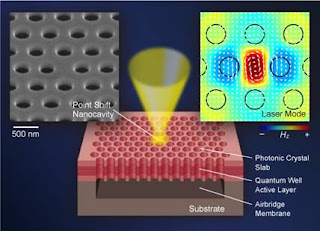Honeycomb-like Photonic Crystal Helps Nanolaser Achieve High Efficiency
The laser is made of a semiconductor material known as gallium indium arsenide phosphate (GaInAsP). The laser's small size and efficiency were made possible by employing a design, first demonstrated at the California Institute of Technology in 1999, known as a photonic-crystal laser. In this design, researchers drill a repeating pattern of holes through the laser material. This pattern is called a photonic crystal. The researchers deliberately introduced an irregularity, or defect, into the crystal pattern, for example by slightly shifting the positions of two holes. Together, the photonic crystal pattern and the defect prevent light waves of most colors (frequencies) from existing in the structure, with the exception of a small band of frequencies that can exist in the region near the defect.
By operating at room temperature and in a mode where laser light is emitted continuously, the new nanolaser from Yokohama National University distinguishes itself from previous designs. For a laser device that depends on the delicate effects of quantum mechanics, the random noise associated with even a moderately warm environment usually overwhelms the process of producing laser light. Yet this laser operates at room temperature. It also produces a continuous output of light, rather than a series of pulses. This desirable continuous operation is more difficult to achieve because it requires careful management of the device's power consumption and heat dissipation.
According to Yokohama researcher Toshihiko Baba, the new nanolaser can be operated in two modes depending what kind of "Q" value is chosen. Q refers to quality factor, the ability for an oscillating system to continue before running out of energy. A common example of an oscillating system would be a tuning fork. The higher its Q value, the longer it will ring after being struck. Lasers are oscillating systems because they produce light waves that repeatedly bounce back and forth inside the device to build up a beam. Nanolasers operated in a high-Q mode (20,000) will be useful for optical devices in tiny chips (optical integrated circuits). In a moderate-Q (1500) configuration the nanolaser needs only an extremely small amount of external power to bring the device to the threshold of producing laser light. In this near-thresholdless operation, the same technology will permit the emission of very low light levels, even single photons.
Article: Kengo Nozaki, Shota Kita, and Toshihiko Baba, "Room temperature continuous wave operation and controlled spontaneous emission in ultrasmall photonic crystal nanolaser," Optics Express, Vol. 15, Issue 12, pp. 7506-7514, full text available at opticsexpress.org/abstract.
About Optics Express Optics Express, the leading optics journal, reports on new developments in all fields of optical science and technology every two weeks. The journal provides rapid publication of original, peer-reviewed papers. It is published by the Optical Society of America and edited by Martijn de Sterke of the University of Sydney. Optics Express is an open-access journal and is available at no cost to readers online at OpticsExpress.org .
About OSA, Uniting more than 70,000 professionals from 134 countries, the Optical Society of America (OSA) brings together the global optics community through its programs and initiatives. Since 1916 OSA has worked to advance the common interests of the field, providing educational resources to the scientists, engineers and business leaders who work in the field by promoting the science of light and the advanced technologies made possible by optics and photonics.
OSA publications, events, technical groups and programs foster optics knowledge and scientific collaboration among all those with an interest in optics and photonics. For more information, visit osa.org. ###
Contact: Colleen Morrison cmorri@osa.org 202-416-1437 Optical Society of America
Technorati Tags: Nano or Nanotechnology and Nanotech and nanolaser or Yokohama National University in Japan and Optical Society of America or gallium indium arsenide phosphate and Researchers Develop Buckyballs to Fight Allergy VIDEO or Currier & Ives Native American Hiawatha's departure and The 5 dimensions of online gifts















No comments:
Post a Comment